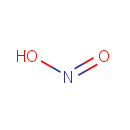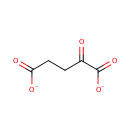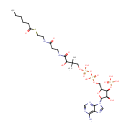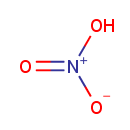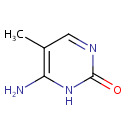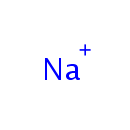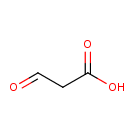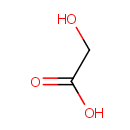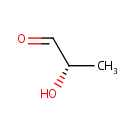
Search Results for compounds
Searching compounds for
returned 4373 results.
Nitrite (PAMDB000465)
IUPAC:
nitrous acid
CAS: 14797-65-0
Description: A nitrite compound is either a salt or an ester of nitrous acid. Sodium nitrite is used for the curing of meat because it prevents bacterial growth and, in a reaction with the meat's myoglobin, gives the product a desirable dark red color. Nitrite can be reduced to nitric oxide or ammonia by many species of bacteria. Several mechanisms for nitrite conversion to NO have been described including enzymatic reduction by xanthine oxidoreductase and NO synthase (NOS), as well as nonenzymatic acidic disproportionation. -- Wikipedia
alpha-Ketoglutarate (PAMDB000466)
IUPAC:
2-oxopentanedioate
CAS: Not Available
Description: Alpha-ketoglutarate is a member of the chemical class known as Gamma Keto-Acids and Derivatives. These are organic compounds containing an aldehyde substituted with a keto group on the C4 carbon atom. Alpha-ketoglutarate is invovled in pentose and glucuronate interconversions, C5-Branched dibasic acid metabolism, Vitamin B6 metabolism, alanine, aspartate and glutamate metabolism, Butanoate metabolism, Glyoxylate and dicarboxylate metabolism, Carbon fixation pathways in prokaryotes, Lysine biosynthesis, Biosynthesis of terpenoids and steroids, and the Citrate cycle (TCA cycle). Alpha-Ketoglutaric acid is one of two ketone derivatives of glutaric acid. (The term ketoglutaric acid, when not further qualified, almost always refers to the alpha variant. Alpha-Ketoglutaric acid varies only by the position of the ketone functional group, and is much less common. Its anion, alpha-ketoglutarate (alpha-KG, also called oxo-glutarate) is an important biological compound. It is the keto acid produced by de-amination of glutamate, and is an intermediate in the Krebs cycle. (WikiPedia)
Hexanoyl-CoA (PAMDB000467)
IUPAC:
{[(2R,3S,4R,5R)-5-(6-amino-9H-purin-9-yl)-2-[({[({3-[(2-{[2-(hexanoylsulfanyl)ethyl]carbamoyl}ethyl)carbamoyl]-3-hydroxy-2,2-dimethylpropoxy}(hydroxy)phosphoryl)oxy](hydroxy)phosphoryl}oxy)methyl]-4-hydroxyoxolan-3-yl]oxy}phosphonic acid
CAS: 5060-32-2
Description: Hexanoyl-CoA is a fatty acid coenzyme A derivative that can be involved in the biosynthesis and oxidation of fatty acids.
Nitrate (PAMDB000468)
IUPAC:
nitric acid
CAS: 14797-55-8
Description: Nitrate is a salt of nitric acid. In organic chemistry the esters of nitric acid and various alcohols are called nitrates. The nitrate ion is a polyatomic anion with the empirical formula NO3- and a molecular mass of 62.01 daltons; it consists of one central nitrogen atom surrounded by three identical oxygen atoms in a trigonal planar arrangement. The nitrate ion carries a negative one formal charge. Nitrates should not be confused with nitrites, the salts of nitrous acid. Organic compounds containing the nitro functional group (which has the same formula and structure as the nitrate ion save that one of the O2 atoms is replaced by the R group) are known as nitro compounds. Nitrate ions can be toxic.
5-Methylcytosine (PAMDB000469)
IUPAC:
6-amino-5-methyl-1,2-dihydropyrimidin-2-one
CAS: 554-01-8
Description: 5-Methylcytosine is a methylated form of cytosine in which a methyl group is attached to carbon 5, altering its structure without altering its base-pairing properties. 5-Methylcytosine is an epigenetic modification formed by the action of DNA methyltransferases. Its function varies significantly among species. In bacteria, 5-methylcytosine can be found at a variety of sites, and is often used as a marker to protect DNA from being cut by native methylation-sensitive restriction enzymes. (Wikipedia)
Sodium (PAMDB000470)
IUPAC:
sodium(1+) ion
CAS: 7440-23-5
Description: Sodium is a metallic element that is soluble in water in nearly all of its compounds, and is thus present in great quantities in the Earth's oceans and other stagnant bodies of water. In these bodies it is mostly counterbalanced by the chloride ion, causing evaporated ocean water solids to consist mostly of sodium chloride, or common table salt. Sodium ion is also a component of many minerals. Export of sodium from the cell provides the driving force for several secondary active transporters membrane transport proteins, which import glucose, amino acids, and other nutrients into the cell by use of the sodium gradient.
O-Acetylserine (PAMDB000473)
IUPAC:
(2S)-3-(acetyloxy)-2-aminopropanoic acid
CAS: 5147-00-2
Description: O-Acetylserine is an intermediate in the biosynthesis of the common amino acid cysteine in bacteria and plants. O-Acetylserine is biosynthesized by acetylation of the serine by the enzyme serine transacetylase. The enzyme O-acetylserine (thiol)-lyase, using sulfide sources, converts this ester into cysteine, releaseing acetate.
Malonic semialdehyde (PAMDB000474)
IUPAC:
3-oxopropanoic acid
CAS: 926-61-4
Description: Malonic semialdehyde is formed in the alternative pathway of propionate metabolism and in the catabolism of beta-alanine.
Glycolic acid (PAMDB000475)
IUPAC:
2-hydroxyacetic acid
CAS: 79-14-1
Description: Glycolic acid (or hydroxyacetic acid) is the smallest alpha-hydroxy acid (AHA). In its pure form, glycolic acid is a colorless crystalline solid. Due to its excellent capability to penetrate skin, glycolic acid finds applications in skin care products, most often as a chemical peel. Glycolic acid is also used for tattoo removal. In Pseudomonas aeruginosa it is involved in glyoxylate and dicarboxylate metabolism.
Lactaldehyde (PAMDB000476)
IUPAC:
(2S)-2-hydroxypropanal
CAS: 598-35-6
Description: L-lactaldehyde is an intermediate metabolite in the pyruvate metabolism pathway. L-lactaldehyde is irreversibly produced from pyruvaldehyde via the enzyme aldehyde reductase (EC:1.1.1.21) which is then irreversibly converted to propylene glycol via aldehyde reductase (EC:1.1.1.21).
